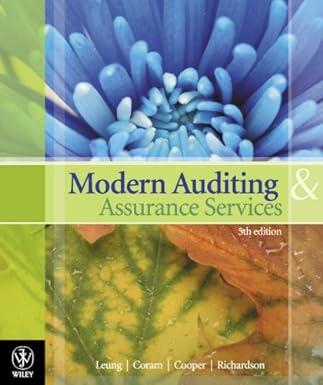Answered step by step
Verified Expert Solution
Question
1 Approved Answer
Ch03 Analytical Procedures [LO3-4] Skip to question Analytical Procedures Audit standards require analytical procedures at two stages during the audit: at the risk assessment (planning)
Ch03 Analytical Procedures [LO3-4] Skip to question Analytical Procedures Audit standards require analytical procedures at two stages during the audit: at the risk assessment (planning) phase and again at the end of the audit. They are optionally used as a substantive procedure during the course of an audit. CONCEPT REVIEW: While analytical procedures are similar in structure in both phases (or substantive testing, if used) of the audit, they have different purposes and often different conclusions. It is critical that the auditors recognize and respond to these differences. Part 1 - Comprehension Case (requires manual grading) Read the case. Then answer the questions based on it. BACKGROUND: Audit standards require that auditors use analytical procedures at two stages in the audit: at the planning, or risk assessment, stage and at the final, or concluding, stages of the audit. In addition, the auditor may decide to use analytical procedures during the substantive testing phase, to obtain evidence about specific accounts to be audited. While analytical procedures may involve similar types of procedures in both the planning and final review phases of the audit, they meet different objectives and require different conclusions and actions on the part of the auditor based on the results. In the planning phase, they are used to help the auditors identify unusual transactions or amounts to highlight the risk of material misstatement. In the final phase of the audit, they are used to assist the auditor in forming the ending conclusions and to ensure all necessary conclusions have been reached. Woo Industries was being audited by BK&D CPAs. Analytical procedures were performed as part of the risk assessment procedures and helped to identify increased accounts receivable balances as the result of loosened credit policies prompted by heightened competition. As a result, BK&D decided to increase their assessment of inherent risk relative to accounts receivable and sent an increased number of confirmations. Analytical procedures were also used during the substantive testing phase to audit the increases in property, plant, and equipment. After the testing, BK&D determined that they had met the audit standard requirements as they had performed two sets of analytical procedures. What step did BK&D CPAs fail to perform? BK&D Why do audit standards require the second (final) set of analytical procedures? Does it make a difference that analytical procedures were performed in testing property, plant, and equipment, as indicated by BK&D CPAs
Step by Step Solution
There are 3 Steps involved in it
Step: 1

Get Instant Access to Expert-Tailored Solutions
See step-by-step solutions with expert insights and AI powered tools for academic success
Step: 2

Step: 3

Ace Your Homework with AI
Get the answers you need in no time with our AI-driven, step-by-step assistance
Get Started


